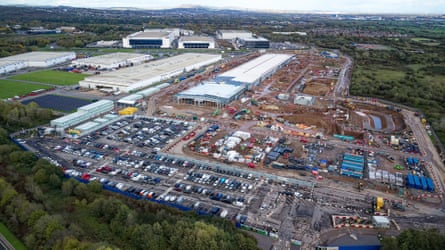The global investment spree in artificial intelligence is producing some remarkable numbers and a projected $3tn (£2.3tn) spend on datacentres is one of them.
These vast warehouses are the central nervous system of AI tools such as OpenAI’s ChatGPT and Google’s Veo 3, underpinning the training and operation of a technology into which investors have poured vast sums of money.
Despite concerns that the AI boom could be a bubble waiting to burst, there are few signs of it at the moment. The Silicon Valley AI chipmaker Nvidia last week became the world’s first $5tn company and Microsoft and Apple’s valuations hit $4tn, the latter for the first time. A restructuring at OpenAI has valued the company at $500bn and a stake owned by Microsoft at more than $100bn. This could lead to a $1tn flotation as early as next year.
On top of that, Google’s owner Alphabet has reported revenues of $100bn in a single quarter for the first time, helped by growing demand for its AI infrastructure, while Apple and Amazon have also just reported strong results.
It is not just the financial world, politicians and tech companies who have faith in AI: it is also the communities hosting the infrastructure behind it.
In the 19th century, demand for coal and steel from the Industrial Revolution shaped the destiny of Newport. Now the Welsh city is hoping for a new chapter of growth from the latest transformation of the global economy.
On the outskirts of Newport, on the site of a former radiator factory, Microsoft is building a datacentre that will help meet what the tech industry hopes will be exponential demand for AI.

Standing on a concrete floor that will soon host thousands of humming servers, the Labour leader of Newport city council, Dimitri Batrouni, says the Imperial Park datacentre is a chance to tap into the economy of the future.
“With cities like mine, what do you do? Do you worry about the past and try to bring steel back with 10,000 jobs – it’s unlikely. Or do you embrace the future?” he says.
But despite the market’s current positivity about AI, questions remain about the sustainability of the tech industry’s outlay.
Four of the biggest players in AI – Amazon, Facebook parent Meta, Google and Microsoft – have increased spending on AI. Over the next two years they are expected to spend more than $750bn on AI-related capital expenditure, meaning non-staff items such as datacentres and the chips and servers inside them.
It is a spending spree that Manning & Napier, a US investment company, describes as “nothing short of incredible”. The Newport site alone will cost hundreds of millions of dollars. Last week, the California-based Equinix said it was planning to invest £4bn on a centre in Hertfordshire.
In March, the chair of the Chinese e-commerce group Alibaba, Joe Tsai, warned he was seeing signs of excess in the datacentre market. “I start to see the beginning of some kind of bubble,” he said, pointing to projects raising funds for construction without commitments from potential customers.
There are 11,000 datacentres globally already, up 500% over the past 20 years. And more are coming. How this will be funded is a source of concern.
Analysts at Morgan Stanley, the US investment bank, estimate that global spending on datacentres will reach nearly $3tn between now and 2028, with $1.4tn covered by the cashflow of the big US tech companies – also known as “hyperscalers”.
That means $1.5tn needs to be covered from other sources such as private credit – a growing part of the shadow banking sector that is raising the alarm at the Bank of England and elsewhere. Morgan Stanley believes private credit could plug more than half of the funding gap. Mark Zuckerberg’s Meta has tapped the private credit market for $29bn of financing for a datacentre expansion in Louisiana.
Gil Luria, the head of technology research at the US investment firm DA Davidson, says the hyperscaler investment is the “healthy” part of the boom – the other part less so, which he describes as “speculative assets without their own customers”.
The debt they are using, he says, could trigger ramifications beyond the tech industry if it goes sour.
“The providers of this debt are so eager to deploy capital into AI, that they may not be properly assessing the risks of investing in a new unproven category supported by very quickly depreciating assets,” he says.
“While we are at the early stages of this influx of debt capital, if it does rise to the level of hundreds of billions of dollars it could end up representing structural risk to the overall global economy.”
Harris Kupperman, a hedge fund founder, said in a blogpost in August that datacentres will depreciate twice as fast as the revenue they generate.

Underpinning this expenditure are some lofty revenue expectations from Morgan Stanley, with revenues from generative AI – chatbots, AI agents, image generators – expected to grow from $45bn last year to $1tn by 2028. Tech companies are relying on businesses, the public sector and individuals to produce enough demand for AI – and to pay for it – to justify those revenue expectations.
OpenAI’s ChatGPT, the emblematic product of the AI boom, now has 800 million active weekly users, which is a boon for the optimists. But doubts have been raised over business takeup so far. For instance, investor faith in the AI boom was rattled in August when the Massachusetts Institute of Technology published research showing that 95% of organisations are getting zero return from their investments in generative AI pilots.
The Uptime Institute, which inspects and rates datacentres, says many projects will not be built – an indicator that some are part of the hype machine and won’t get off the ground.
“An important point to understand is that a lot of this speculative,” says Andy Lawrence, the executive director of research at Uptime. “Many of the datacentres, often announced with a fanfare, either will never be built, or will be built and populated only partially, or gradually, over a decade.”
He adds that many of the datacentres announced in this multitrillion-dollar programme will be “either specifically intended to support AI workloads, or will mainly do so”.
Microsoft points out that its Newport datacentre will not be used solely for AI. As well as being the central nervous systems for AI systems such as ChatGPT and Microsoft’s Copilot, datacentres do all the day-to-day IT work we take for granted – as providers of “cloud” services where companies rent out servers instead of buying their own: handling email traffic, storing company files and hosting Zoom calls.
“We have a lot of ways to use this infrastructure. It becomes very much a general purpose technology,” says Alistair Speirs, a general manager at Microsoft’s cloud business.
Elsewhere, though, are massive projects that are all-in on AI. The Stargate venture in the US is a $500bn joint venture between OpenAI, Oracle and SoftBank that aims to build a network of AI datacentres across the US. A UK version of Stargate is also coming to North Tyneside in north-east England. Microsoft is building the word’s most powerful AI datacentre in Fairview, Wisconsin, and is backing an AI-dedicated site in Loughton, Essex, while Elon Musk’s xAI has built the “colossus” project in Memphis, Tennessee.
Work on an estimated 10GW of new datacentre capacity around the world – representing roughly a third of the UK’s power demand – is expected to start this year, according to the property group JLL. However, this is the aggregate maximum capacity and datacentres typically operate at about 60%.
A further 7GW will reach completion this year, according to JLL.
Currently, global datacentre capacity is 59GW, so the pace of expansion is rapid and Goldman Sachs expects it to double by the end of 2030. This carries a further infrastructure cost of its own, according to Goldman, with $720bn of grid spending needed to meet that energy demand.
At the Newport site, a native of the city, the construction safety specialist Mike O’Connell, has returned as a consultant. After a career that has spanned oil rigs, offshore wind and datacentres around the world, he is back at his birthplace – now a tech hub that hosts datacentres and semiconductor companies.
“I am looking to stay in the local community,” he says. O’Connell’s teenage grandson is starting work at the Newport site under an electrical apprenticeship. There is a belief, and hope, that datacentres such as this represent a generational employment opportunity for the area.
Investors and tech companies, having pledged trillions of dollars, are counting on a long-term return, too.

.png) 6 hours ago
3
6 hours ago
3

















































